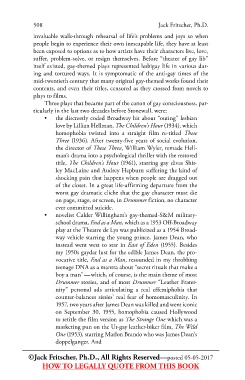Page 528 - Gay San Francisco: Eyewitness Drummer - Vol. 1
P. 528
508 Jack Fritscher, Ph.D.
invaluable walk-through rehearsal of life’s problems and joys so when
people begin to experience their own inescapable life, they have at least
been exposed to options as to how artists have their characters live, love,
suffer, problem-solve, or resign themselves. Before “theater of gay lib”
itself existed, gay-themed plays represented lesbigay life in various dar-
ing and tortured ways. It is symptomatic of the anti-gay times of the
mid-twentieth century that many original gay-themed works found their
contents, and even their titles, censored as they crossed from novels to
plays to films.
Three plays that became part of the canon of gay consciousness, par-
ticularly in the last two decades before Stonewall, were:
• the discreetly coded Broadway hit about “outing” lesbian
love by Lillian Hellman, The Children’s Hour (1934), which
homophobia twisted into a straight film re-titled These
Three (1936). After twenty-five years of social evolution,
the director of These Three, William Wyler, remade Hell-
man’s drama into a psychological thriller with the restored
title, The Children’s Hour (1961), starring gay divas Shir-
ley MacLaine and Audrey Hepburn suffering the kind of
shocking pain that happens when people are dragged out
of the closet. In a great life-affirming departure from the
worst gay dramatic cliche that the gay character must die
on page, stage, or screen, in Drummer fiction, no character
ever committed suicide.
• novelist Calder Willingham’s gay-themed-S&M military-
school drama, End as a Man, which as a 1953 Off-Broadway
play at the Theatre de Lys was publicized as a 1954 Broad-
way vehicle starring the young prince, James Dean, who
instead went west to star in East of Eden (1955). Besides
my 1950s gaydar lust for the edible James Dean, the pro-
vocative title, End as a Man, resounded in my throbbing
teenage DNA as a mantra about “secret rituals that make a
boy a man” — which, of course, is the main theme of most
Drummer stories, and of most Drummer “Leather Frater-
nity” personal ads articulating a real effemiphobia that
counter-balances sissies’ real fear of homomasculinity. In
1957, two years after James Dean was killed and went iconic
on September 30, 1955, homophobia caused Hollywood
to retitle the film version as The Strange One which was a
marketing pun on the Ur-gay leather-biker film, The Wild
One (1953), starring Marlon Brando who was James Dean’s
doppelganger. And
©Jack Fritscher, Ph.D., All Rights Reserved—posted 05-05-2017
HOW TO LEGALLY QUOTE FROM THIS BOOK

